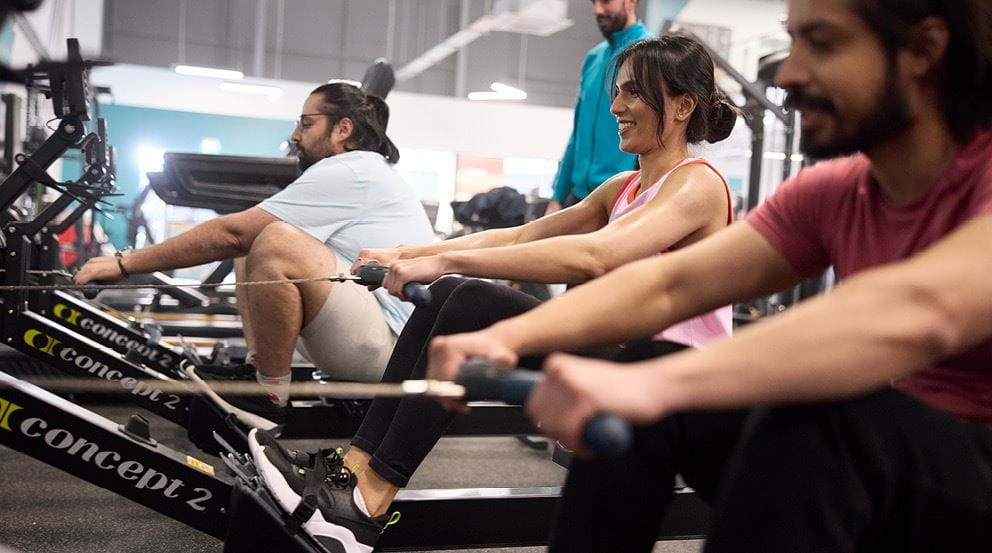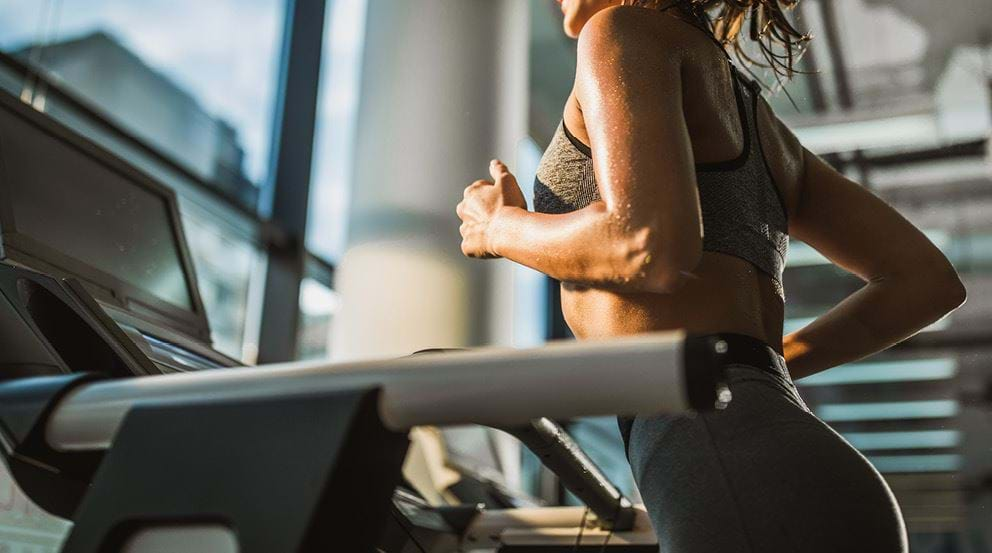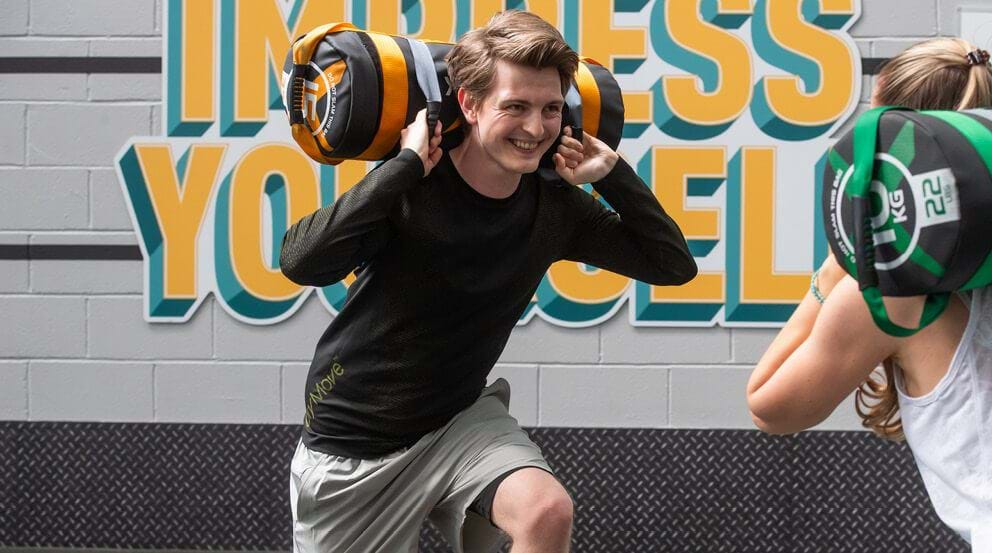Hyrox Row Guide: Everything You Need to Know

What Is Rowing Event | Benefits | Damper Setting | Distance | Average Time | Exercises | Pacing | Common Mistakes | Training Plan | FAQs
Training for a Hyrox event means mastering the ability to pace and perform well under fatigue. We've been sharing training tips for each of the 8 Hyrox stations in our Hyrox blog series; today we'll be covering the Hyrox rowing station.
PureGym Stockport Assistant Manager, PT and Hyrox athlete Marcus Rayfield share his best advice on training, technique, and race-day strategy so you can smash the row and stay strong for the rest of the race.
What Is the Rowing Event in Hyrox?
Hyrox races are made up of 8 sets of 1,000m runs and a functional fitness station. The fifth station is a 1,000m row on the Concept2 rower, which means you’ll run 1,000m, row 1000m, then get straight out on another 1000m run.
By the time you reach the rower, you'll already have done five 1,000m runs and four different fitness stations, with plenty more still to come. Your engine will already be taxed. which is why technique and pacing are important.
What Are the Benefits of Rowing?
Rowing offers training benefits that extend beyond Hyrox competition day:
Cardiovascular endurance. Rowing is an excellent cardiovascular exercise, building both endurance and the ability to maintain power output under accumulated fatigue.
Full body strength and conditioning. Rowing works multiple muscles in the body, including the legs, arms, shoulders, back, and core.
Low impact. This is a low impact, joint friendly cardio activity.
Skill transference. Rowing strength and endurance transfers well to the sled push, sled pull, and ski erg.
What Setting Will You Use for the Rower?
Rowing is one of the few Hyrox stations where you can adjust the equipment settings, meaning you can choose the Hyrox row setting that matches your race strategy, strength profile, and training experience.
The damper setting works by adjusting the amount of air taken into the flywheel housing on the side of the rower. A higher damper setting allows more air in, making it harder to spin.
- Lower settings (1-4): to work on speed and stroke rate, requires higher cadence
- Medium settings (5-7): balanced approach for most athletes during Hyrox rowing
- Higher settings (8-10): increased resistance but can lead to early fatigue
A damper setting of around 5-7 is ideal for balancing power generation with the ability to keep going for 1,000m, so start with this and use your training to find which setting works best for you.
What Rowing Distance Will You Need to Cover in Hyrox?
The Hyrox rowing distance is 1,000 meters across all competition categories and divisions. 1,000m requires both power and endurance – it’s long enough to need sustained effort but short enough that technique and pacing can significantly impact your time.
What Is the Average Time of the Rowing in Hyrox?
There are many factors that can impact your Hyrox rowing times, from training experience and technique to age and even things like dehydration and sleep. Understanding average times can help you set realistic goals and give you something to aim for in your training.
Beginner competitors typically complete the 1,000m in 4:30 - 5:30 minutes, intermediate athletes often finish in 3:45 - 4:30 minutes. Elites can do the row in as little as 3:15 minutes.
The average Hyrox row time for recreational athletes falls around 4:30 minutes, but don't let these numbers add pressure. Focus on maintaining a steady rhythm and keeping your technique efficient. Remember, you’ve still got 3 x 1000m runs, the farmer’s carry, sandbag lunges, and wall balls to go!
6 Best Training Exercises to Improve Your Rowing Performance
Practice rowing is one of the best ways to improve your rowing technique and endurance but that shouldn’t be the only training you do for the Hyrox row station.
Including exercises that build rowing-specific strength and movement patterns is one of the best ways to increase your rowing power and speed. Many of these exercises transfer well to other Hyrox stations too.
Bent over rows: builds posterior chain strength and pulling power for stroke efficiency
Face pulls: strengthens rear deltoids and improve posture for sustained technique.
Cable/machine rows: builds specific pulling strength with controlled resistance.
Deadlifts: develops hip hinge mechanics and posterior chain power for leg drive.
Plank variations: strengthen core for efficient power transfer.
Squat jumps: build explosive leg power for strong drive phase.
Pacing Yourself for the Rowing Event in Hyrox Competitions
The Hyrox row is the fifth station in a Hyrox event, so strategic pacing is essential. At this point in the race, you'll be fatigued and you'll need to preserve energy for the rest of the race.
The smartest athletes avoid the temptation to sprint early which is hard to maintain. Instead, aim to maintain 26-30 strokes per minute, and focus on powerful leg drive and keeping an efficient rhythm.
- Start at controlled intensity, around 80-85% effort
- Maintain consistent stroke rate throughout the distance
- Think about strong leg drive rather than arm pulling
- Save any intensity for the final 250m if you feel strong
Common Mistakes and How to Avoid Them
Technical mistakes during the row Hyrox station can sap your energy and slow you down. The most common mistakes are:
Over pulling with your arms. Driving through your legs should be the main source of power for your row. Overusing the arms reduces power output and efficiency, meaning you'll move slower while using up more energy.
Setting the damper too high. A high damper setting creates more resistance and can lead to early fatigue.
Inconsistent pacing. Inconsistency causes spikes in heart rate which increases recovery time.
Poor posture. Poor posture strains the back, reduces core efficiency, and makes it harder to row efficiently.
is over-pulling with your arms (you should think about driving through your legs), setting the damper too high, inconsistent pacing that spikes heart rate, and poor posture that leads to energy leaks and a sore back.
Remember to drive through your legs, set that damper between 5-7, and settle into a strong steady rhythm that allows you to breathe. 1000m is a fair way to row, so don't try to sprint it.
How Can You Incorporate Row Training Into Your Hyrox Preparation Plan?
Your Hyrox row prep should include a mix of specific rowing training to build good technique and fitness, exercises to build strength and power in the muscles involved in rowing, and race simulation sessions to practice transitions and rowing under fatigue.
Aim to do 1-2 rowing sessions per week, starting by building a solid base with longer steady-state sessions at a moderate intensity to develop aerobic capacity. You can then bring in threshold training, such as sustained efforts at race pace, and interval work like short, high-intensity repeats to build power and speed.
Here’s a Hyrox rowing workout you can try that develops the energy systems and pacing skills you’ll need on race day, and builds your confidence in maintaining speed under fatigue:
Workout: 400m Row Repeats
- 400m row at race pace effort
- Rest for half the time it took to complete the row
- Repeat 3-6 times
Aim for a consistent pace across the efforts. For example, if the 400m row took you 1:40, you'd rest for 0:50.
You'll need to balance your row training with training for the other Hyrox stations. Check out our free 12 week Hyrox training plan to help get started.
FAQs About Hyrox Rowing
Your Hyrox row time depends on your fitness, technique, and experience as well as individual factors like height and age. Focus on good technique and a steady pace rather than comparing yourself to others.
Include 1-2 specific rowing sessions in your weekly Hyrox training, including steady state workouts for endurance and technique and intervals for practicing power and working under fatigue.
Hyrox competitions use Concept2 rowers, so you should try to access these in training to familiarise yourself with the damper, display, and general feel of the machine. You can find Concept2 rowers in your nearest PureGym.
Both are important, but endurance typically takes priority for the 1,000m Hyrox rowing distance. Train for sustainable power output rather than short bursts of max effort.


